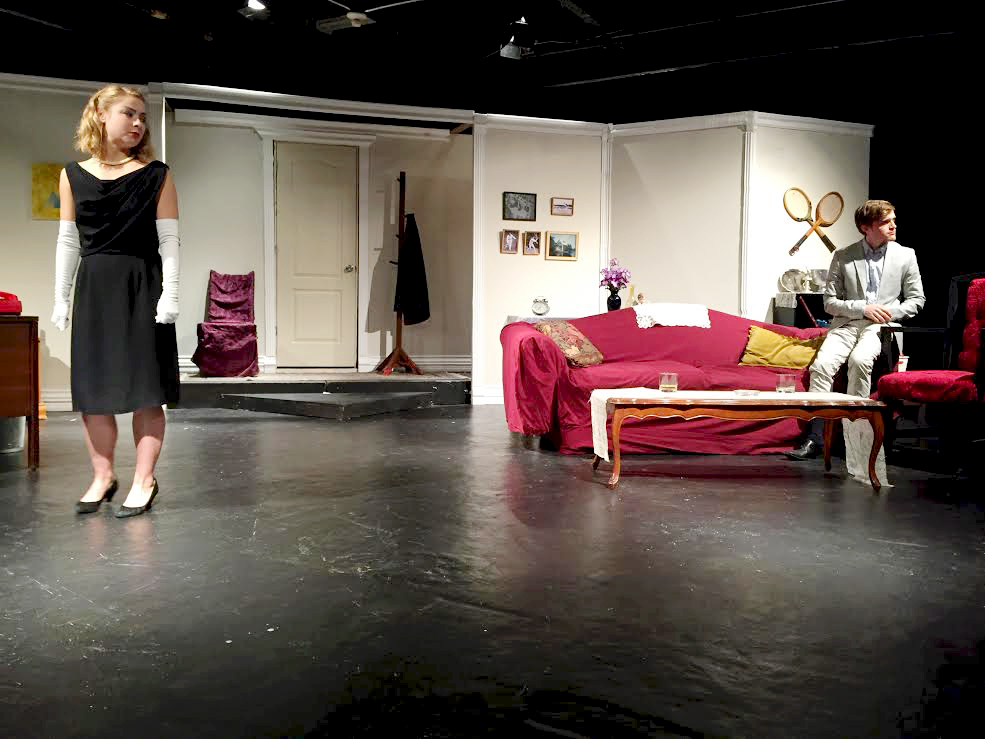Players’ Theatre’s production of Frederick Knott’s Dial M For Murder, which ran from October 14 to 24, shows how a sinister undercurrent of murderous intention can pervade the charming facade of the picturesque 1950s. The characters gleefully portray all kinds of immorality, including adultery, false identity, blackmail, and betrayal, throughout the performance, weaving an intricate narrative of intrigue and suspense.
The play begins with Sheila Wendice (Eleonore Lamothe) and Max Halliday (Jordan Pollock) sitting in Wendice’s living room, making idle conversation over drinks. It soon becomes clear that they have had an affair, even though she is married to the ex-tennis pro Tony Wendice (Oskar Flemer). Tony, a man of great charm, has discovered his wife’s affair and plans to kill her. With the help of the play’s director, Ali Aasim, events turn darkly humourous as characters struggle to hide or uncover the truth about a murder plot gone awry.
Aasim makes his directing known in many elements throughout the play, such as the use of music and lighting to emphasize dramatic and important moments that reinforce key characters’ revelations. The performances are well- timed, especially in scenes where tensions between characters run high. Stand-out performances include Lamothe’s Sheila Wendice and Flemer’s Tony Wendice: the former for portraying Sheila with grace and true emotional depth throughout tumultuous character developments, and the latter for demonstrating subtle predatory behaviour with just the right amount of passive-aggression that characterizes his charm. These performances synthesize well with some of the key design elements of the show to make for a truly satisfying result.
Critics have rightly pointed out the lack of female representation, and the written implications of Sheila being physically and emotionally weak. Lamothe fights against this interpretation by making her version of Sheila distinctly assertive, constantly countering her husband’s manipulation.
The character of Sheila is particularly well-performed in light of the widely-known misogyny inherent to the play. Critics have rightly pointed out the lack of female representation, and the written implications of Sheila being physically and emotionally weak. Lamothe fights against this interpretation by making her version of Sheila distinctly assertive, constantly countering her husband’s manipulation.
Notably, Cain Humeniuk’s portrayal of Inspector Hubbard is a steadfast anchor in many scenes. The true talent of his performance comes from Hubbard’s antagonistic dialogue with Tony Wendice, whereby the audience begins to see cracks in Tony’s rather confident persona. Alastair Pitts’ portrayal of Captain Lasgate is also a decent performance of a rather complex character, and Pitts plays the part without being overly dramatic.
The scenery, created by set designer Chip Limeburner, takes a minimalist but effective approach in constructing the Wendice home, and the set’s strengths are determined by its attention to detail thanks to artistic director Zoë Vnak. From the Jameson Irish Whiskey bottle and polished tennis trophies to the fake lit cigarettes used by the performers, attention to smaller elements of the show contribute to the overall authenticity of the 1950s veneer. This also comes through in the production’s costume choices, with tailored suits donned by the male characters and the fedora worn by Inspector Hubbard. Sheila’s costumes are probably the most aesthetically appealing: beautiful dresses with cinched waists and long elegant white gloves that emphasize not only the cultural period but also the character’s grace.
The use of macabre music in scene transitions and climactic scenes is also an important element for the show’s overall morbid content. The same can be said for Sharanya Venkatesh’s lighting design: in a particularly climactic scene, dark red light cloaks the whole set to reflect a deliberate horror. All of these important design choices along with Aasim’s nuanced direction give way to a very satisfying performance.
The show’s strength comes from the collaborative effort of the cast members who play off of one another and who demonstrate exceptional dialogue tempo. The result is a show that simultaneously contains both drama and humour in an enticing display.
